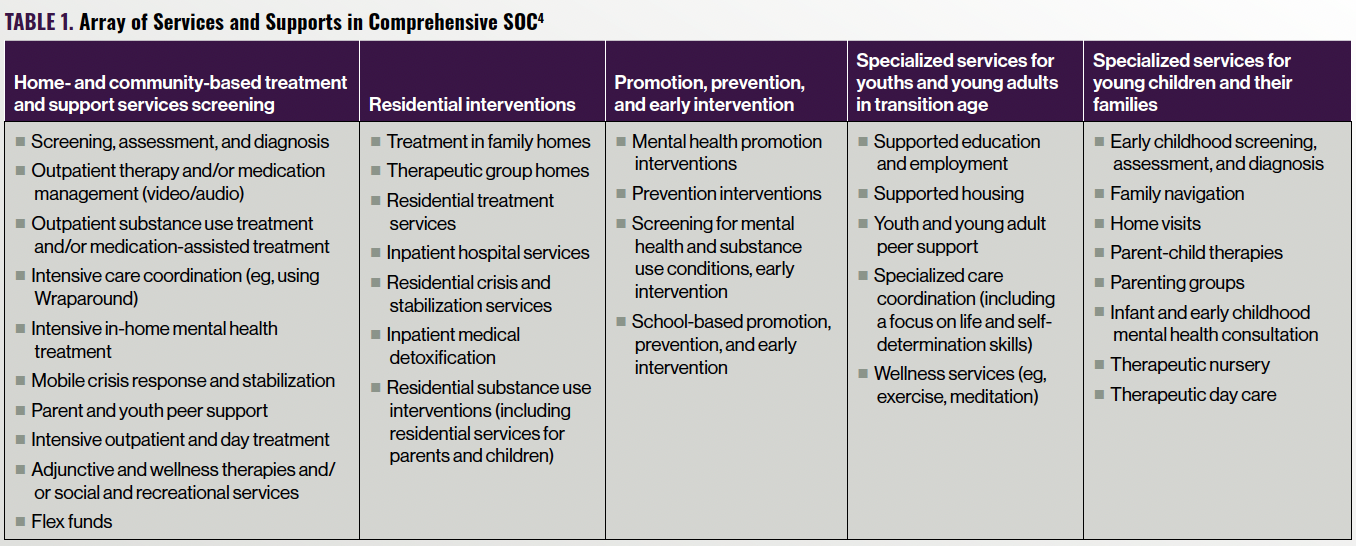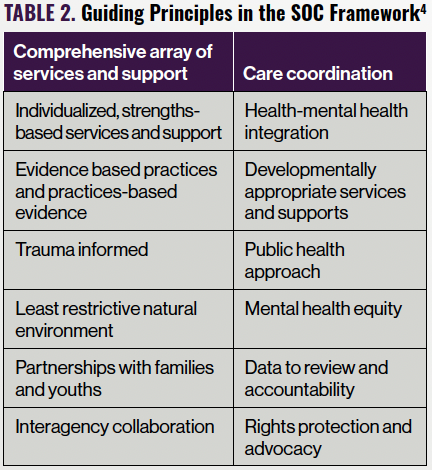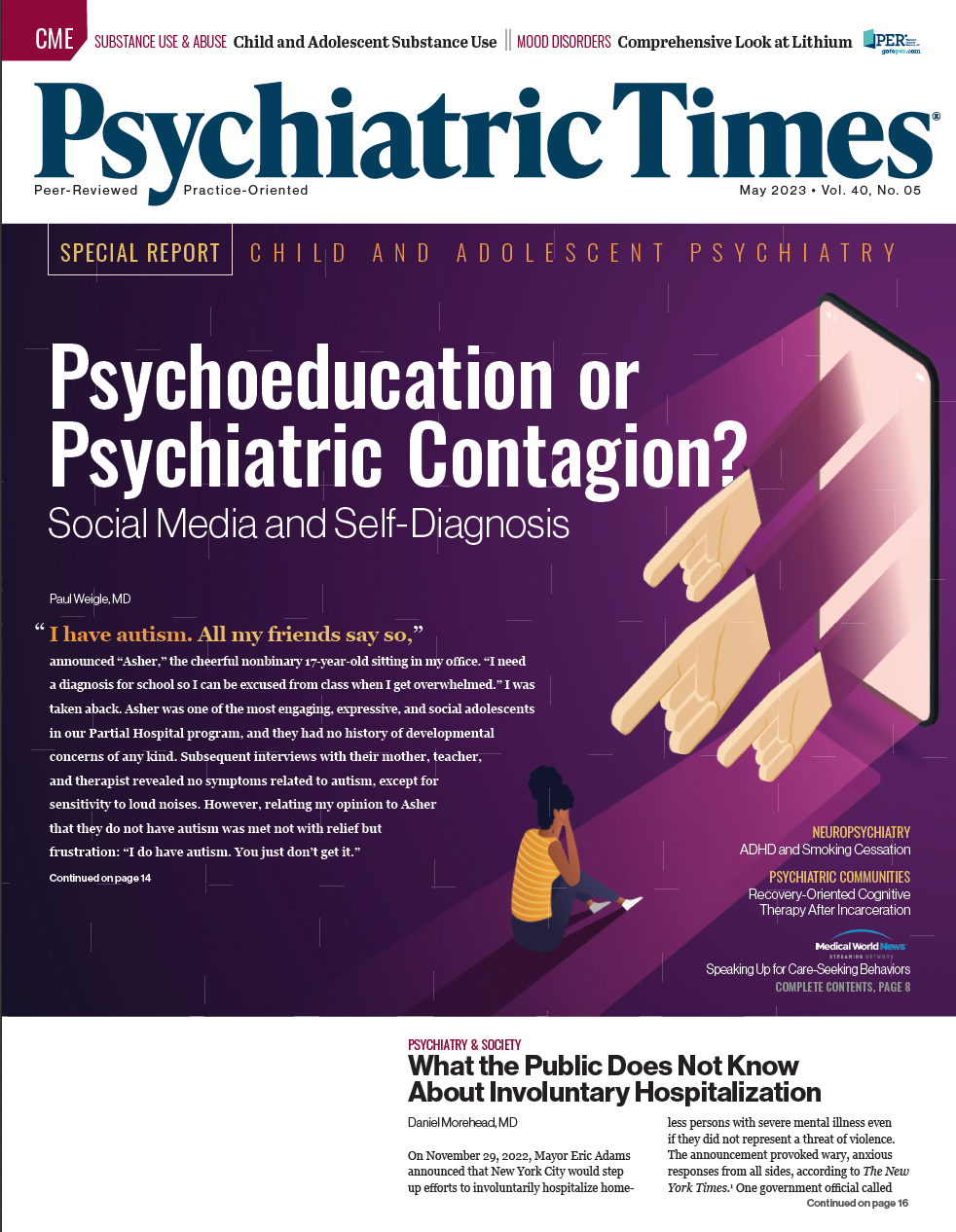Publication
Article
Psychiatric Times
Systems of Care & Collaborative Approaches: An Answer to the Youth Mental Health Emergency
Author(s):
Mental health needs have skyrocketed in the US, but access to treatment remains inadequate. Here's how we can help youth.
New Africa/AdobeStock

SPECIAL REPORT: CHILD AND ADOLESCENT PSYCHIATRY
Mental health needs, including emergency department visits and suicide rates among youths, have skyrocketed in the US, but access to treatment remains inadequate. Before the COVID-19 pandemic, approximately half of the children with mental health needs in the US were not receiving treatment from a mental health professional.1 The pandemic exacerbated this crisis by further decreasing access to treatment and increasing psychosocial risk factors such as family unemployment, social isolation, and increased family stress.2 Consequently, a National Emergency in Children’s Mental Health was declared in a joint communication by the American Academy of Pediatrics, the American Academy of Child & Adolescent Psychiatry (AACAP), and the Children’s Hospital Association.3
Families cannot find mental health care for their loved ones; psychiatrists experience an insatiable need for their services; emergency departments are overrun by youths in crisis and waiting for an inpatient bed for days, if not weeks—many would argue that the mental health system needs to be fixed. But the key questions are: How do we fix it? And where do we start?
We need a roadmap to forge a path forward as we address the many gaps in our mental health system for youths. One useful framework for conceptualizing the strengths and weaknesses of the system for youths is the Systems of Care (SOC) framework.4,5 The SOC framework has evolved since its inception in the 1980s and has 3 components or elements: (1) an array of services and supports, (2) an infrastructure to fulfill these functions, and (3) a philosophy about how these services should be provided.5
Array of Comprehensive Services in SOC
Table 1. Array of Services and Supports in Comprehensive SOC4

The array of services in the SOC framework goes beyond the traditional (and currently available) array of services. For many communities, mental health services are limited to standard clinic-based outpatient psychiatric services and an inadequate number of inpatient psychiatric beds. A comprehensive array of services for youths includes options that better address the individual needs of patients and their families and can provide services in the least-restrictive natural environment (eg, homes or/and locations closer to home), targeting the individual’s strengths (Table 1).4 Community-based services in settings “where youths are,” such as schools, pediatrician offices, and homes, can have a positive effect on youth and family well-being. In addition, other familiar organizations and individuals (eg, faith-based systems, neighbors) in the community offer an additional positive support system.
Restrictive settings, such as inpatient psychiatric hospitalization and residential treatment, are an important part of the continuum of care, but complementary robust home and community services also are required to reduce the extended need for restrictive settings and to reduce recidivism. When youths are discharged from these restrictive settings, they find it difficult to assimilate into their original environment or may experience the same environmental factors that exacerbate their function, leading to further placement in restrictive settings, and the cycle continues. Caregivers of youths in serious emotional distress often are stressed and perceive that they are out of alternatives and may consider placing the youths in a restrictive setting. Physicians should educate families about services to support placement in the least restrictive environment. Examples of home- and community-based services that can supplement more traditional services arrays include mobile crisis response and stabilization services (MRSS), intensive in-home mental health treatment services, parent and youth peer support, respite care, flex funds (funding mechanisms to purchase nonrecurring goods not covered by other financing sources), and therapeutic foster care. Specific therapeutic processes and models closely aligned with SOC principles are described below.
Infrastructure
A large workforce network delivers an array of SOC services, including psychiatrists, primary care physicians, paraprofessionals, peer support staff, and local agency/organization staff. A national shortage of professionals to address the mental health needs of youths has been well documented. There is a significant shortage of child and adolescent psychiatrists and other professionals, with 70% of counties in the US having no child and adolescent psychiatrists.6 The needs are further reflected by the fact that there are only 14 child & adolescent psychiatrists per 100,000 children in the US.7
In addition to an adequate workforce, coordination between providers and systems providing care to children and adolescents is imperative, highlighting the need for system and data management, interagency partnerships, care coordination, youth and family organizations, and workforce development to provide strength-based mental health care to young individuals.
Figure. Core Values in the SOC Framework4

Philosophy of SOC
The SOC framework is founded on core values (Figure) and guiding principles (Table 2),4 including family-driven, youth-centered, community-based, and culturally and linguistically competent systems and services. Mental health equity is a key guiding principle to underscore, given the increasing awareness of major disparities in access and outcomes for many minoritized youths. Attention to these principles requires resources and effort through education and data monitoring.
Table 2. Guiding Principles in the SOC Framework4

Specific Service Models or Processes
Several specific models of care or processes are particularly aligned with SOC principles and deserve further elaboration.
Care Coordination and Wraparound
Care coordination is an important element of youth mental health care, without which youths receive fragmented care and no system keeps another system abreast of progress. Wraparound is an intensive and well-structured process with youths and families at the center.
The wraparound process has 4 steps: (1) engagement, (2) plan development, (3) implementation and monitoring, and (4) transition. The wraparound/intensive care coordinator (or facilitator) engages with the youth, family, and family’s friends and community members, such as family/youth peer support partners, to create a wraparound workforce or team. The youth and family at the center lead and decide their goals from their perspective. This stage is also called plan development or individualized plan development phase. The wraparound workforce then takes necessary actions to support and implement the plan devised by the youth and family. The youth and family’s individualized plan is monitored and amended frequently.
MRSS
MRSS is designed to diffuse the emergent situation and assist the family when the youth is experiencing a mental health crisis. The overarching goal of MRSS is to prevent overutilization of the emergency department and other acute care settings, including inpatient hospitalization. These services typically involve therapeutic responses in a crisis, which can be delivered through a face-to-face, telephonic, or video consultation with a clinician. The crisis team provides the stabilization intervention in the youth’s natural environment or wherever the event occurred (home, school, or other settings). After crisis intervention, the MRSS team follows up with the family and youth to evaluate the need for additional services and builds those connections.
Intensive In-Home Mental Health Treatment Services
In-home mental health services are comprehensive interventions involving parent management training, family therapy, individual and family skill building, and care coordination. These services improve child and family interaction and functionality, ultimately reflecting on the youth’s well-being. These services also aim to prevent outside-home placement to inpatient psychiatric hospitals or residential treatment programs. In-home mental health treatment services are available in several states, and child psychiatrists should be aware of their state and/or county-level contacts to refer patients. Given the flexibility in delivering these services, youths can receive these services at home, school, and community. The use of telepsychiatry services has increasingly taken the place of face-to-face interventions.
Parent and Youth Peer Support
Peer support includes a range of activities and interactions with individuals with similar experiences who have recovered from a mental health condition. Peer support workers share their knowledge of what works and what does not through their experience, but they do not replace therapists, case managers, or other treatment team members. Through peer interaction, youths and their family members develop treatment goals and build ideas for self-empowerment. In some states, peer support is covered through Medicaid. Peer support can be particularly helpful in promoting treatment engagement.
Flex Funds
Flex funds are state (or grant) funding mechanisms commonly used to purchase nonrecurring goods not covered by other financing sources, such as housing, utilities, grocery, and transportation. The funds are intended to maintain access to primary and emergency health care services and improve the quality of services.
Respite Care
Respite care provides short-term relief for primary caregivers or parents, giving youths a place to stay in a safe and supportive environment. Such arrangements help relieve parent burnout and reenergize parents who are caring for a child in serious emotional distress. It can be arranged for an afternoon, several days, or even weeks. Respite care can be provided at home, with another family, or in a foster or group home.
Service Intensity Needs Assessment
Tools to assess the range of services needed for a particular youth are key to effectively targeting the most appropriate services for children and adolescents with mental health needs. Two service intensity assessment tools that were built on the SOC approach can help determine the level of needed service intensity: (1) the Child and Adolescent Service Intensity Instrument (CASII)8 for children and adolescents aged 6 to 18 years, and (2) the Early Childhood Service Intensity Instrument (ECSII)9 for children 5 years or younger.
Training on SOC Framework and Practice
Given the usefulness of the SOC framework in assessing the strengths and weaknesses of the mental health system, psychiatrists need to be familiar with this model. Several resources comprehensively describe SOC principles.4,5 AACAP has developed tools to aid trainees in child psychiatry in developing core competencies specific to working in SOC, including a Training Toolkit for Systems-Based Practice. In addition to this toolkit, AACAP has provided several resources for psychiatrists, including training modules for the CASII and ECSII service intensity instruments.
Concluding Thoughts
In summary, how do we fix a “broken system?” Although understanding the SOC framework does not fix the mental health system for youths in the United States, it does help structure a to-do list. As leaders in the mental health system, psychiatrists can benefit from a framework that guides our direction and action steps. Youths and families need access to the comprehensive mental health service array beyond the traditional service models. The system needs to include an adequate infrastructure, not only a sufficient workforce but a workforce coordinating and communicating with one another.
Lastly, there must be a process to monitor and assess adherence to specific values and principles, such as mental health equity, including family and youth voices, and the goal of least restrictive settings. The SOC framework helps psychiatrists, as leaders within the systems where we work, assess the needs of our current service array while remaining grounded in important values and principles so that any system we build promotes important ideals such as equity, respect, and dignity of youths and families.
Dr Sharma is an assistant professor of psychiatry and psychology at Mayo Clinic Health System in Eau Claire, Wisconsin. Dr Larson is the medical director of schools and residential treatment centers for Sheppard Pratt in Baltimore, Maryland.
Disclosures
Dr Larson and Dr Sharma are AACAP’s Systems of Care committee members. Dr Larson is an employee of Sheppard Pratt and is consulting editor for the Child and Adolescent Psychiatric Clinics of North America. Dr Sharma is an employee of Mayo Clinic and Mayo Clinic Health System and a recipient of the Robert A. Winn Diversity in Clinical Trials Career Development Award, funded by the Bristol Myers Squibb Foundation.
References
1. Whitney DG, Peterson MD. US national and state-level prevalence of mental health disorders and disparities of mental health care use in children. JAMA Pediatr. 2019;173(4):389-391.
2. Manchia M, Gathier AW, Yapici-Eser H, et al. The impact of the prolonged COVID-19 pandemic on stress resilience and mental health: a critical review across waves. Eur Neuropsychopharmacol. 2022;55:22-83.
3. AAP-AACAP-CHA declaration of a national emergency in child and adolescent mental health. American Academy of Pediatrics. Updated October 19, 2021. Accessed March 22, 2023. https://www.aap.org/en/advocacy/child-and-adolescent-healthy-mental-development/aap-aacap-cha-declaration-of-a-national-emergency-in-child-and-adolescent-mental-health/
4. American Academy of Child and Adolescent Psychiatry Committee on Community-Based Systems of Care and AACAP Committee on Quality Issues. Clinical update: child and adolescent behavioral health care in community systems of care. J Am Acad Child Adolesc Psychiatry. 2023;62(4):367-384.
5. Stroul BA, Blau GM, Larson J. The evolution of the system of care approach for children, youth, and young adults with mental health conditions and their families. The Institute for Innovation & Implementation. 2021. https://www.cmhnetwork.org/wp-content/uploads/2021/05/The-Evolution-of-the-SOC-Approach-FINAL-5-27-20211.pdf
6. McBain RK, Kofner A, Stein BD, et al. Growth and distribution of child psychiatrists in the United States: 2007-2016. Pediatrics. 2019;144(6):e20191576.
7. Severe shortage of child and adolescent psychiatrists illustrated in AACAP workforce maps. The American Academy of Child & Adolescent Psychiatry. May 4, 2022. Accessed March 22, 2023. https://www.aacap.org/aacap/zLatest_News/Severe_Shortage_Child_Adolescent_Psychiatrists_Illustrated_AACAP_Workforce_Maps.aspx
8. Child and Adolescent Service Intensity Instrument (CASII) 2022. American Academy of Child & Adolescent Psychiatry. Accessed March 22, 2023. https://www.aacap.org/aacap/Member_Resources/Practice_Information/CASII.aspx
9. Early Childhood Service Intensity Instrument (ECSII). American Academy of Child & Adolescent Psychiatry. Accessed March 22, 2023. https://www.aacap.org/aacap/Member_Resources/Practice_Information/ECSII.aspx#:~:text=What%20is%20the%20Early%20Childhood,from%20ages%200%2D5%20years







